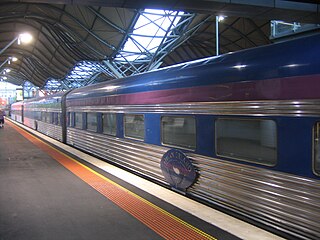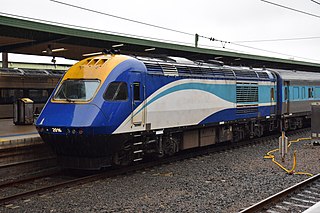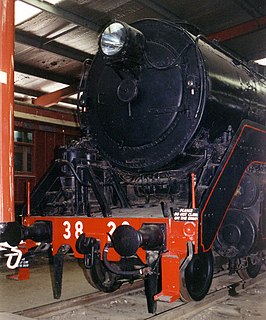
The C38 class was a class of steam locomotive built for the New South Wales Government Railways in Australia.

The Main North Line is a major railway in New South Wales, Australia. It runs through the Central Coast, Hunter and New England regions. The line was the original main line between Sydney and Brisbane, however this required a change of gauge at Wallangarra. As of 1988, the line closed progressively north of Armidale with services gradually withdrawn till 2004, with the main route between Sydney and Brisbane now the North Coast line.

The Overland is an Australian passenger train service between Melbourne and Adelaide. It first ran in 1887 as the Adelaide Express, but has been called the Melbourne Express by South Australians. It was given its current name in 1926. Now operated by private company Journey Beyond, the train completes two return trips a week covering 828 kilometres between the state capitals. Originally an overnight train, it now operates during the day. The Overland was converted to standard gauge in the 1990s and now operates from Melbourne over the longer standard gauge line initially heading south to the port city of Geelong, before returning to its original route in Ararat. After departing Ararat the train stops in the Victorian towns of Stawell, Horsham, Dimboola and Nhill before crossing the South Australian border. The final stretch into Adelaide, after crossing the Murray River is over the scenic Adelaide Hills. The train contains both Red Premium and Red seated accommodation, along with the cafe 828 bar / lounge car.

The Flying Scotsman is an express passenger train service that has operated between Edinburgh and London, the capitals of Scotland and England, via the East Coast Main Line. The service began in 1862; the name was officially adopted in 1924. It is currently operated by London North Eastern Railway.

The Central Coast & Newcastle Line is a NSW TrainLink passenger train service that runs along the Main North railway line in New South Wales, connecting the state's two largest cities, Sydney and Newcastle. The service runs from Central through to Broadmeadow on the Main North railway line to Newcastle Interchange on the Newcastle railway line, and services the Hawkesbury River region, the Central Coast and the city of Newcastle.

3801 is a 4-6-2 steam locomotive operated by the New South Wales Government Railways between 1943 and 1974. It is arguably Australia's most famous steam locomotive, being the only one to have visited all mainland states and territories.

The Spirit of Progress was the premier express passenger train on the Victorian Railways in Australia, running from Melbourne to the New South Wales border at Albury, and later through to Sydney.
The Unanderra–Moss Vale railway line is a cross country railway line in New South Wales, Australia. The line branches from the Illawarra line at Unanderra and winds west up the Illawarra escarpment to join the Main South line at Moss Vale. The line is one of the most scenic in New South Wales, and for the first 20 km after leaving Unanderra has an almost continuous grade 1 in 30 providing extensive views over the Illawarra coastline.
The railways of New South Wales, Australia, use a large variety of passenger and freight rolling stock. The first railway in Sydney was opened in 1855 between Sydney and Granville, now a suburb of Sydney but then a major agricultural centre. The railway formed the basis of the New South Wales Government Railways. Passenger and freight services were operated from the beginning. By 1880, there was a half hourly service to Homebush.

The New South Wales XPT is the main long-distance passenger train operated by NSW TrainLink on regional railway services in New South Wales, Australia from Sydney to Dubbo, Grafton and Casino as well as interstate destinations, Brisbane, and Melbourne. The XPT is based on the British Rail designed High Speed Train and entered service in April 1982.

3830 is a 4-6-2 steam locomotive operated by the New South Wales Government Railways between 1949 and 1967. It has been preserved by the Powerhouse Museum and is based at the NSW Rail Museum, Thirlmere. It was operational from 1997 until 2009 and was scheduled to return to service in 2016 before the need for more extensive boiler repairs was discovered.

3820 is a 4-6-2 steam locomotive operated by the New South Wales Government Railways between 1947 and 1970. It has been preserved by the Trainworks Railway Museum, Thirlmere.

The New South Wales C36 class was a class of two-cylinder, simple, non-condensing, coal-fired superheated, 4-6-0 express passenger steam locomotives built by Eveleigh Railway Workshops and Clyde Engineering for the New South Wales Government Railways in Australia.

The Inter-Capital Daylight was a passenger train that operated between Australia's two largest cities, Sydney and Melbourne from March 1956 until August 1991.

3112 is a two-cylinder, simple, non-condensing, saturated, coal-fired ‘Baltic’ type, 4-6-4 steam C30 class tank locomotive built for the New South Wales Government Railways in 1914 by Beyer, Peacock and Company.
The HUB type carriage stock was a type of air conditioned passenger carriage operated by the New South Wales Government Railways from April 1948 until April 2000.

The 1200 class railcar or Tulloch railcar were a type of diesel railcar built by Tulloch Limited for the New South Wales Government Railways between June 1970 and May 1972. They were built to operate the Riverina Express before being transferred to the South Coast Daylight Express.
The Southern Highlands Express was an Australian passenger train operating on the Main South line in New South Wales from Sydney to Goulburn.
The Brisbane Limited was an Australian passenger train operated by the New South Wales Government Railways between Sydney and Brisbane from 1888 until February 1990.

The Western Endeavour was the first steam locomotive hauled train to operate across from Sydney on Australia's east coast to Perth on the west coast in 1970.














